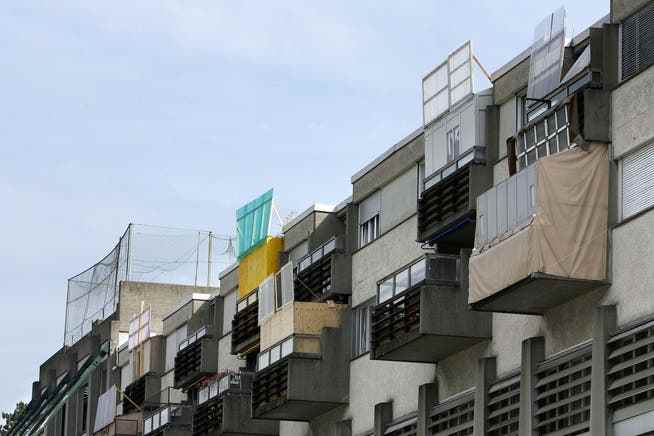An insight into the Jewish Feast of Tabernacles.
Colorful garlands adorn a sukkah in Wiedikon.
Once you have seen one, you suddenly notice them everywhere: since last week there have been many small wooden huts on balconies and in courtyards in the Wiedikon and Enge quarters. Most have a hinged corrugated plastic roof. Others are covered only with bamboo sticks and pine branches. Light leaks outside from the windows. Jewish men and women go in and out. You can hear them singing and laughing.
What are you doing?
practice abstinence
Called Jehuda Spielman, who is a member of the Zurich municipal council for the FDP and is a member of the Jewish-Orthodox community in Zurich. Spielman is staying with his wife and son in Manchester with his wife’s family. They celebrate the Feast of Tabernacles, Sukkot in Hebrew. The huts in Zurich were also set up for this festival.
With the festival, the Jews commemorate the exodus of the Israelites from Egypt. During their hike through the desert, they spent the night in makeshift tents. Even today, Jewish Orthodox families symbolically leave their own safe house and practice abstinence for seven days. Yehuda Spielman puts it this way: “The Tabernacle teaches us not to overestimate the possession of material goods.”
At the same time, the Feast of Tabernacles, which is celebrated in September or October, is a harvest festival. On the streets of Zurich these days you can see many Jewish men with long rods in their hands. These are palm branches that were mostly imported from Egypt especially for the festival. They are tied together with myrtle branches and brook willows in a kind of bouquet and taken to prayer with an etrog, a special citrus fruit.
The four plants stand for different types of enjoyment. The etrog symbolizes taste and smell. The palm branches, on which dates grow, represent taste, the myrtle branches smell, and the willows of the stream represent the absence of both. During prayer, the plants are waved in the four cardinal directions. This as an expression of the hope for good weather and a plentiful harvest.
Eat and drink in the open air
Yehuda Spielman’s parents also set up a sukkah in their courtyard. There are three such provisional buildings close together in front of the apartment building. The Spielman family gives us a glimpse into the cabins.
The first is decorated with lush garlands reminiscent of Christmas decorations. In the middle of the room is a long table with a white tablecloth and black folding chairs. The walls are covered with white cloths, on which colored pictures and silhouettes hang.
The Spielmans’ cabin is simpler. Colorful paper streamers and plastic grapes dangle from the ceiling. Handicrafts by children and pictures of bearded men hang on the walls, which are covered with white cloth. Seven drawings symbolize prominent forefathers of Judaism, such as Abraham, Moses and King David. Each day of the Feast of Tabernacles a meal is dedicated to one of them.
Another poster shows the commandments of the tabernacle: it must not be too high and it must not be under a tree. However, huts on a tree or even on a ship are allowed.

Many tabernacles are on balconies.
“The Feast of Tabernacles is a family celebration with much singing and dancing,” says Ms. Spielman. 15 of their 13 children and 30 grandchildren are celebrating in their hut this year. Every evening she cooks three or four courses for her family – mostly Swiss specialties such as rösti, spaetzli, schnitzel and cured meat. The adults drink wine with it. A little tipsy is even desirable for once, says Spielman and smiles.
Eating is done in the hut – even when it’s cold, but not when it’s raining – and the feast usually lasts an hour and a half. Then you just put on a jacket, says Spielman. But many a friend also has a small electric oven in his house. In bad weather, the roof can also be closed.
The festival begins and ends with two days of rest. Many families use the days in between for excursions, for example to Conny-Land or to the Flumserberge. The men go to the synagogue three times a day during the Feast of Tabernacles. The first prayer of the day lasts up to two hours, those in the afternoon and evening 20 minutes. Women were also allowed to go, but mostly stayed at home, says Ms. Spielman. “I’m happy when I can sleep in, and in the evening I have to take care of the food.”
Important when looking for an apartment
Sukkot is one of the most important festivals of the year for the Jewish community. So important that it even plays a role in the choice of apartment. The tabernacle must be in the open air, since the men are not allowed to eat or sleep under one roof during the festival. You spend the night on fold-up beds in the hut. Therefore you need a balcony that is not covered or a courtyard where you can place the hut.
In England, says Jehuda Spielman, single-family houses are sometimes built in such a way that the roof of the living room can be opened. There is an apartment building with staggered balconies on Manessestrasse. The architects planned it specifically for the Feast of Tabernacles.
The Spielmans bought their hut many years ago from a non-Jewish carpenter, former SVP councilor Bruno Garzotto, in District 4. They appreciate the interreligious exchange – also with their neighbors. This year, the Quartiertreff Enge opened its hut to anyone who is interested. It can be visited until Sunday.
